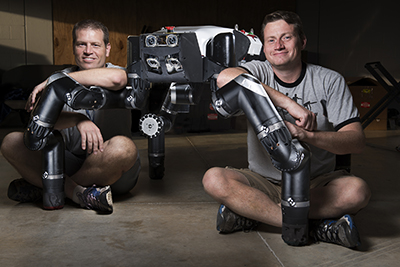How are we going to explore distant planets? With robots, of course.
By Derek Herscovici ’14
RoboSimian (Cylde) with Brett Kennedy (left) and Chuck Bergh. RoboSimian, developed to respond to mass industrial accidents such as the Fukushima Daiichi Nuclear Power Plant meltdown in 2011, placed 5th worldwide in the DARPA Robotics Challenge. December 2013. Courtesy NASA/JPL-Caltech.
But by the time Bergh was ready for college, his dream of pursuing a career in aerospace seemed as dim as Saturn’s rings. When he got to Auburn University, he switched his major from aerospace to mechanical engineering and set his sights on a career in manufacturing, securing a job with electronics giant TDK Corporation after graduation.
“We’d seen the beginnings of the ‘peace dividend’ start to kick in because we had already ended hostilities with the Russians at that point,” Bergh says, “and America just wasn’t spending as much on its defense program at the time.”
Nearly three decades later, though, Bergh is the lead test and integration engineer for the Vision Compute Element of the Mars 2020 mission, named Perseverance and launched this past summer, which will seek signs of ancient life and collect rock and soil samples for possible return to Earth.
“The Vision Compute Element is a computer we built to improve landing accuracy,” Bergh says. “For example, the landing sites for the previous Spirit and Opportunity rovers were roughly 100 kilometers by 10 kilometers, or about the size of a county. For Perseverance, we have tightened that to a 40 meter diameter circle, or about half a football field.”
Bergh got the opportunity to reclaim his childhood dream of working for NASA while he pursuing his doctorate in engineering at Georgia Institute of Technology in the late 1990s. As luck would have it, he happened to get an interview with the Jet Propulsion Laboratory, where they essentially offered to pay him to do the work he was about to do for free during his Georgia Tech doctorate.
“I grew up watching the Apollo program, the Space Shuttle program, and all these really cool things happening,” Bergh says, “and suddenly I’m being invited to join that club. So I jumped on the opportunity to come out to Pasadena.”
Bergh started his career with NASA in robotics, and that’s where he’s been ever since — including work on RoboSimian, an ape-like robot that competed in the DARPA Robotics Challenge finals in 2015. An engineer with a master’s degree among a team of PhDs, Bergh is affectionately called “Howard Wolowitz,” the character from The Big Bang Theory, by his wife Tanja. Now, with the Mars 2020 mission, Bergh has been able to transfer his engineering expertise from a walking robot to a driving rover.
“When I came to JPL, I started working on these portable robots, which later became PackBot from iRobot and picked up by the military,” Bergh says. “This is what they were sending into the caves to protect our soldiers trying to clear caves and in Iraq and Afghanistan. At the same time, I was also working on new ways to land on comets, and those techniques have evolved into what we’re using for Mars now.”
What’s unique about Mars 2020 is that Bergh and his team have come up with the first purpose-built instrument that will change personalities during a mission. When Perseverance lands, the team will load new software into the Vision Compute Element that will transform it from a landing computer to a driving computer.
“What most people don’t know,” Bergh says, “is that all the previous rovers would drive for a little bit, stop, look around, assess their surroundings, choose a new path, and then move forward again. The whole purpose of this new computer is to allow the rover to drive on the surface continuously.”
Bergh’s plan for the foreseeable future is to keep answering the calls of what the NASA scientists come up with next, including working to provide terrain-relative navigation for the Human Landing System for the Artemis program, which intends to land the first woman and the next man on the moon by 2024.
But one of the areas he’s particularly interested in is a mission to the ocean moons orbiting Saturn and Jupiter.
“We’re working on some cool technologies to explore these water vents and cryo volcanoes that exist on these other moons,” Bergh says. “We’re developing a snake robot that could potentially crawl its way down into them and investigate.”
Though Bergh has seen many changes in manufacturing technologies since he got that serendipitous interview with JPL twenty years ago — innovations like additive manufacturing and 3D printing that allow NASA engineers to make better motors and structures for going to these far-off places — neither his curiosity nor his passion has been satisfied.
“I still think about my grandfather a lot,” Bergh says. “He grew up in central Alabama at the turn of the century, and yet he saw so much in his lifetime: the Battle of the Bulge, the entire Apollo and Space Shuttle programs.”
“I’m hoping that I can see nearly half as much change in my lifetime as he saw.”
An Eye for Action
From the mound to the mountain, Blake Gordon ’03 has captured life on the edge.
Charting Her Course
From Auburn’s campus to the world’s most advanced warships, Emily Curran ’10 has never forgotten where she found her footing.
Building a Brand, Cultivating a Community
A fashion emergency and a social media surge helped Kayla Jones ’18 launch her brand Women With Ballz.
An Eye for Action
From the mound to the mountain, Blake Gordon ’03 has captured life on the edge.
Charting Her Course
From Auburn’s campus to the world’s most advanced warships, Emily Curran ’10 has never forgotten where she found her footing.
Building a Brand, Cultivating a Community
A fashion emergency and a social media surge helped Kayla Jones ’18 launch her brand Women With Ballz.



